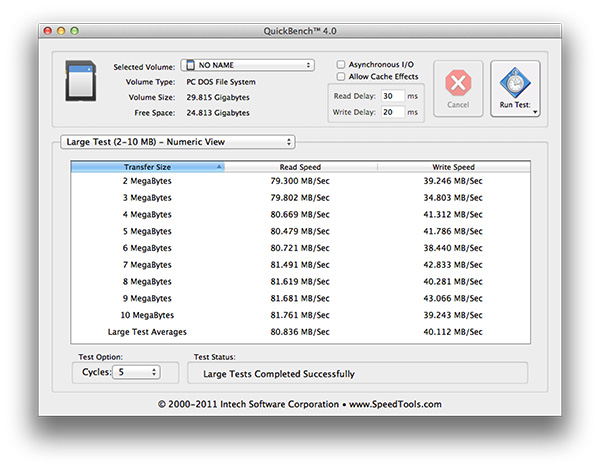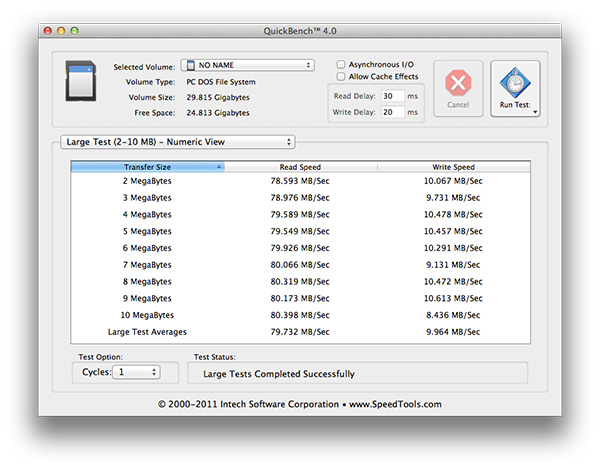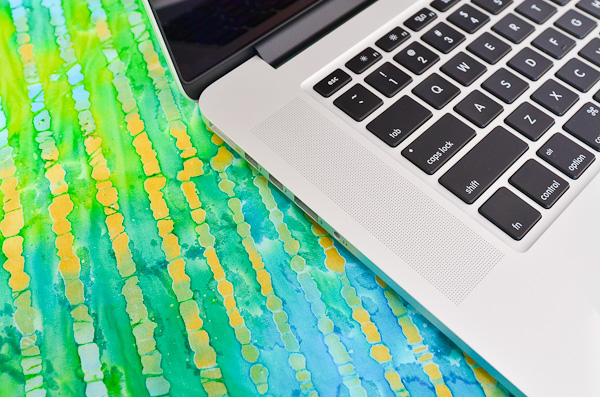The next-gen MacBook Pro with Retina Display Review
by Anand Lal Shimpi on June 23, 2012 4:14 AM EST- Posted in
- Mac
- Apple
- MacBook Pro
- Laptops
- Notebooks
WiFi Performance
The next-gen MacBook Pro is equipped with a decidedly this-gen wireless stack. In other words it uses the same 3x3:3 WiFi solution that was present in the 2011 MacBook Pro and is present in the non-Retina 2012 MacBook Pro as well: Broadcom’s BCM4331. The wireless behavior characteristics are a bit different since this is a physically different chassis, but we’re still dealing with a 3-stream 802.11n solution - not 802.11ac. All three antennas are located in the Retina Display’s housing.
We have seen Apple be conservative with component choices in the past. Deciding to stick with Samsung’s 45nm LP process for the A5X instead of embracing 32nm LP sooner with the 3rd gen iPad is one example that comes to mind. Like a good silicon company Apple appears to mitigate risk in design by sticking with known-good components wherever possible. Major changes to the industrial design are typically paired with comparatively minor silicon changes, and other components are kept as static as possible so long as they don’t overly compromise experience. While 802.11ac dongles and routers are just arriving today, Apple likely froze the Retina MBP’s wireless configuration quite a while ago. Rather than be caught shipping potentially unratified hardware, Apple went the safe route and stuck with 802.11n.

That’s not to say Apple’s wireless implementation is bad. The 15-inch MacBook Pro has been one of the best behaved notebooks on wireless that I’ve had the pleasure of using. The MacBook Pro with Retina Display is no different. Just like before, the best case negotiated physical rate is 450Mbps when paired with a 5GHz 3x3 access point. Unobstructed, within a couple of feet of the AP, I measured as much as 230Mbps to the Retina MacBook Pro. I tested at three different distances from the AP, through walls and on both 2.4GHz and 5GHz bands. Overall performance seemed comparable to the standard 15-inch MacBook Pro, although it’s definitely faster in some areas and slower in others.
| Location 1 | Location 2 | Location 3 | |
| 2011 MacBook Pro (2.4GHz) | 124.0 Mbps | 12.6 Mbps | 61.6 Mbps |
| Retina MacBook Pro (2.4GHz) | 117.9 Mbps | 87.6 Mbps | 44.0 Mbps |
| 2011 MacBook Pro (5GHz) | 186.8 Mbps | 154.6 Mbps | 24.7 Mbps |
| Retina MacBook Pro (5GHz) | 227.7 Mbps | 156.8 Mbps | 33.7 Mbps |
The second test location consistently performed poorly on the 2011 MBP, only on 2.4GHz however. For the most part there were no real surprises otherwise.
The SD Card Reader
It was our own Brian Klug who clued me into the horrible behavior of the 2011 MacBook Pro’s SD card reader. Depending on the SD card used, the integrated SD card reader either performed admirably or was the most frustrating part of the Mac experience. Out of the three SD cards I frequently use: a Patriot LX series card, a Transcend and a new UHS-I Patriot EP Pro, only the Transcend card actually works remotely well with the 2011 chassis. Even then, it’s not perfect. I usually have to insert and remove the card at least once before the reader will recognize it. The LX and EP Pro on the other hand are measurably worse. To get the EP Pro to work in the 2011 MBP’s reader I usually have to push the card in then apply upward or downward force to the exposed edge of the card to get it to read properly. Even then it’ll usually disappear from OS X or be present but read at bytes per second. I doubt this is the fault of the card itself but rather the latest example of incompatibility with the horrible SD card reader in last year’s MacBook Pro.
At least with the cards I’ve tested, the Retina MacBook Pro exhibits none of these issues. Over dozens of insertions I had no issues reading from or writing to all three of these cards, including the problematic ones. I ran a Quick Bench test on the EP Pro as it’s the fastest of the lot and came away with reasonable performance as well. Roughly 80MB/s reads and 40MB/s writes. The numbers are shy of Patriot’s 90/50 spec but quite good.
One of the times I was able to get the EP Pro working in the 2011 MacBook Pro I managed to squeeze in a single Quick Bench run. Read performance was almost identical at 80MB/s, but write performance was far lower at only 10MB/s:
Shortly after the test completed I could no longer write to the drive in the 2011 MBP so I suspect the card reader was acting up again. Needless to say, if you like using SD cards with your MacBook Pro the Retina Display model appears to be much better. That’s not to say there couldn’t be other incompatibilities, but in everything I tested it looks like this problem is finally fixed.
Better Speakers and Dual Mics
Apple is proud of its new speaker design in the Retina MacBook Pro. There’s not a whole lot you can do for tiny laptop speakers but despite shrinking the overall volume of the chassis, Apple has managed to deliver much better sound out of the new speakers in the rMBP. Like most of the upgrades to the next-gen MacBook Pro, you really need to do an A/B comparison to appreciate the difference. And keep your expectations in line with reality, a good set of external speakers are always going to sound better. With that said, the new speakers definitely deliver a fuller, more rich sound than their predecessor. You can still tell you’re listening to some form of integrated speakers, but now they sound distinctly less like they’re coming from a inside a notebook.
In preparation for Mountain Lion's arrival with dictation support, Apple outfitted the next-gen MacBook Pro with dual microphones in order to better focus on your spoken voice and not on background noise. In practice the new mics work reasonably well, rejecting moderate volume background noise. Loud music nearby will still cause interference and as always, accurate dictation requires more than just good quality source audio to get right.













471 Comments
View All Comments
OCedHrt - Sunday, June 24, 2012 - link
He missed another important point. All of that was in 3 lbs. Now, the current generation starting from last summer has an external discrete graphics and optical drive connected via a thunderbolt based connector (because Apple had exclusivity) with the laptop being only 2.5 lbs.This isn't going to compare to the retina macbook pro though - at 15 inches 4.5 lbs is pretty impressive though I think if Sony wanted to do it they could do 4 lbs or less.
deathdemon89 - Saturday, June 23, 2012 - link
I agree completely, I'm a proud owner of the old Z, and even today it doesn't feel the least bit dated. And the 1080p screen is holding up admirably well, with no signs of pixellation at normal viewing distances. This device was truly innovative for its time. I still don't understand why it received such mixed reviews by the press.Spunjji - Monday, June 25, 2012 - link
Mainly the price. Only Apple are allowed to charge that much for a laptop. Also, only Apple can have hot systems. Repeat ad infinitum.mlambert890 - Wednesday, November 28, 2012 - link
Really ridiculous comment. I can see you are bitter, as is the other mega z fan, but come on already. I worked for Sony for 5 years and love the company. I have owned probably a dozen Vaios including the top of the line last gen Z (with the SSD RAID)Instead of ranting and raving you need to ask yourself *why it is* that "only Apple can charge so much" and why "Anand only gives a free pass to Apple"
You feel what exactly? That there is some grand conspiracy in play? Do you realize how ridiculous that sounds?
WHY has Sony *lost the ability to charge a premium*? In other words WHY have they *burned all customer loyalty and good will*? I left the company back in 1999 because I saw the writing on the wall.
You (and the other Z guy) are no different than any other apologist. Companies dont bleed marketshare and fail to sell cancer curing products (you guys are presenting the Z as "truly revolutionary" right?) for no reason. Sorry to tell you there is no "big conspiracy".
Sony sells super high priced products into a super commoditized market and then they layer on a CRAP TON of bloatware dragging the machine to a stop, make idiot decisions like the HDMI one, and push proprietary crap *worse* than Apple ever has. All of that into the Wintel space which, sorry to tell you, was *always* driven by the cheapest possible parts at the best possible price.
The PC industry grew *because it was cheap*. Apple *always* occupied a premium niche. I vividly remember the initial release of the Apple I, the Lisa, the Mac 128. These were all always premium products and the competition at the time (be it Commodore, Atari, Ti, or the wintel ecosystem) *always* captured share by being cheap.
That may annoy you for some reason, but Apple has pretty much *always* held a core premium audience. The only exception was the period of insanity when Jobs had been pushed out and Scully destroyed the company. Even then, the core fans stayed.
You two make it sound like poor Sony is a victim because the world doesnt all run out and by the Vaio Z.
Even *without Apple* Sony would be going under, hate to tell you. Sony's problems are Sony's and the whole is *not* the sum of its parts with a laptop.
solipsism - Saturday, June 23, 2012 - link
None of that makes sense and is, in fact, rubbish.Sony added 1080p because it was it was popular not because it made sense. You have a 168 PPI display on 13" machine which makes text too small to be a good experience for most users.
They also didn't use a good quality display or add anything to the SW to make the experience good (unlike what Anand talked about in this review), they just added the single metric that was trending because of HDTVs.
Blu-ray in a notebook has always been a silly option for most users. There is a reason the BRD adoption failed on PCs and it's not because everyone is stupid... except you. ODDs are long overdue for being removed since they take up 25% of the chassis, require them to placed at an edge reducing over 5" of port real estate and restricting design, require a lot of power, are noisy, more prone to break due to the many moving parts, are slow, are just too expensive to be feasible, and add nothing visually that most users trying to watch a movie can discern.
Quad-SSDs? Really? That's a sensible solution for a consumer notebook?
EnzoFX - Saturday, June 23, 2012 - link
and that really is what people don't get. It isn't just about raw specs. The package needs to be complete, polished, what have you. In this case of high dpi screens, is good scaling support, and Apple did it. Support on the software side is something they never get credit for by the Apple haters. All they can see is numbers and think "I've seen numbers like that before".mabellon - Saturday, June 23, 2012 - link
No Apple didn't do it. Just like on the iPad, they increased resolution by doubling width and height. Their software simply doesn't scale well to arbitrary higher resolution. If it was done right then Chrome would work out of the box - instead the OS 2x scales everything without increasing resolution/quality.To the consumer, the choice means a good experience without breaking apps. But claiming that Apple was successful simply bc of software? HA!
Ohhmaagawd - Saturday, June 23, 2012 - link
Did you actually read the retina part of the review?Chrome doesn't work right because they do their own text rendering. Read the review. If an app uses the native text rendering, the app will look good (at least the text portion). They will have to update the graphical assets of course.
BTW, Chrome Dev builds have this issue fixed.
Windows DPI setting isn't default, so few use or even know about the setting and devs haven't made sure they work properly in the high DPI settings.
Apple has made a move that will be short-term painful in having apps that aren't updated look a bit fuzzy. But since they made it default, this will force devs to update.
OCedHrt - Sunday, June 24, 2012 - link
What do you mean Windows DPI setting isn't default? You can change it in a few clicks, but the same thing applies - if your app does not read the DPI values, then Windows can't help you. This is because windows UI is not vector based (I don't know about now, but older apps definitely not) and many applications back then were coded with hard coded pixel counts.When the DPI is changed, windows scales the text but the UI dimensions is controlled by the application implementation.
KitsuneKnight - Saturday, July 7, 2012 - link
On Windows, changing the DPI will generally mean a huge amount of applications will become simply unusable.On this Retina MBP, the worst case appears to be slightly blurry text (which was quickly updated).
Apple's solution is a good one, because it does things in a way that should keep existing apps working fine, while allowing future developers to leverage new APIs to take advantage of the increased resolution.